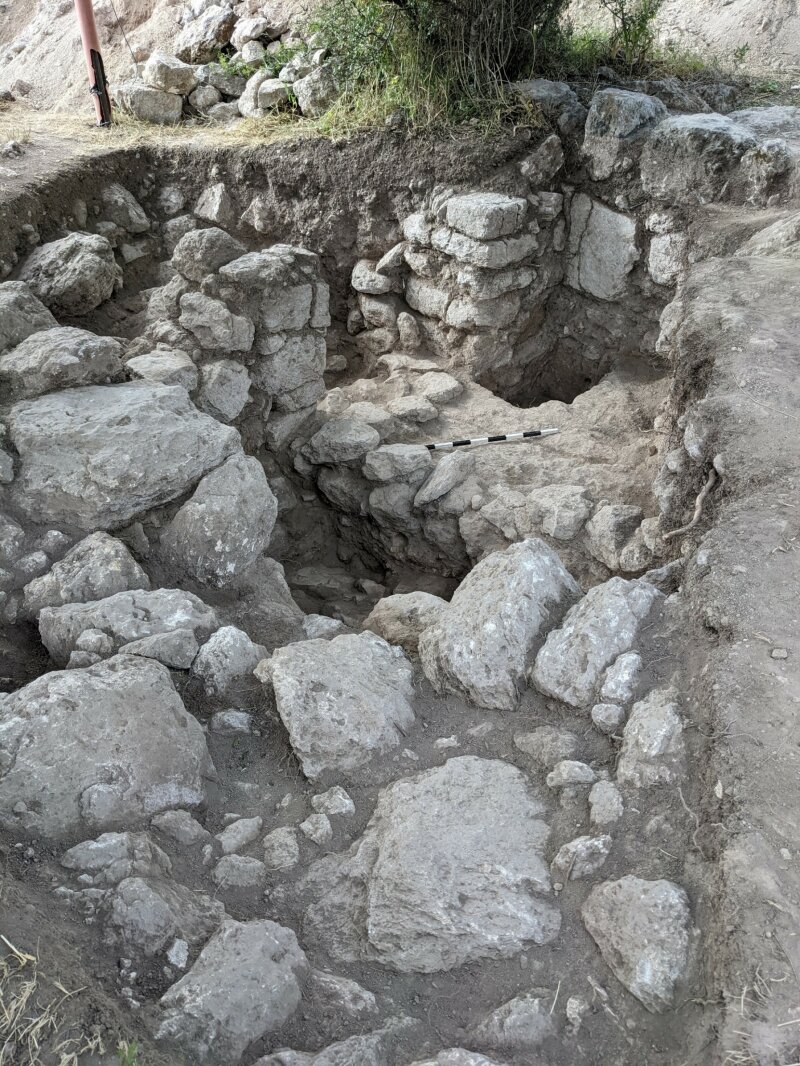Contact: Prof. Dr. Bärbel Morstadt
In 2022, a joint research project by Meir Edrey (University of Haifa) and Bärbel Morstadt (Ruhr University Bochum) on mobility, infrastructures and resources of the early Iron Age in the Levant was launched (Fig. 1), focussing in particular on a previously largely unknown site called Khirbet es-Suwweida.
The site was first mentioned in 1908 by Eberhardt von Mülinen, who noted the remains of a fortress, which he identified as part of a medieval castle (Eberhard von Mülinen, Beiträge zur Kenntnis des Karmels, Zeitschrift des Deutschen Palästina-Vereins 31,1908, 1-258). In the 1960s, it was used by the Israeli defence forces as a training ground. In the course of this, trenches were dug with the help of mechanical tools, which damaged most of the visible remains, but also yielded interesting finds such as complete so-called hippo jars. In the 1970s, the site was investigated by Ya'akov Olami; the results of this investigation were updated in the 1990s by Shlomo Sender and Eldad Oren and finally published in 2005 (Ya'aqov Olami - Shlomo Sender - Eldad Oren, Map of Binyamina (48). Archaeological Survey of Israel. Jerusalem: Israel Antiquities Authority (2005). They found pottery from the Iron Age, Persian, Hellenistic, Roman and Byzantine periods, identified a rectangular fortress measuring 70 x 70 metres with four towers and dated it to the Iron Age. In 2020, Eran Arie considered Khirbet es-Suwweida in his study on the relationship between Phoenicia and the Northern Kingdom of Israel and related it to Dor, Tel Mevorakh and Rosh Zayit (Eran Arie, Phoenicia and the Northern Kingdom of Israel: the archaeological evidence, in Barış Gür and Semra Dalkılıç [eds.], A life Dedicated to Anatolian Prehistory: Festschrift for Jak Yakar [Ankara 2020] 1-19).
However, the significance of Khirbet es-Suwweida is unclear, as too much is unknown: What is the exact age? How many phases of settlement and utilisation were there? Was it a military base or a fortified agricultural centre? Were there neighbouring settlements? How did the site develop? Was there continuous utilisation? Was there any destruction?

© Meir Edrey
Fig. 2: The Early Iron Age phase.

© Meir Edrey
Fig. 3: The Hellenistic phase.

© Meir Edrey
Fig. 4: The Roman phase.
With financial support from the German Israeli Foundation for Scientific Research and Development, archaeological excavations were carried out in 2022, which revealed two major phases, namely an Early Iron Age phase (Fig. 2) and a Hellenistic phase (Fig. 3), as well as a smaller subsequent use in the Roman pre- and early imperial periods (Fig. 4). In each case, a monumental fortress with unexpectedly massive walls emerges, which only lasted a few decades and was soon abandoned - not destroyed. The finds are also reminiscent of Horvat Rosh Zayit and Kabri. Thanks to funding from the Institute of Archaeological Sciences at the Ruhr University Bochum and the Leon Recanati Institute for Maritime Studies at the University of Haifa, a campaign was carried out with the participation of students to confirm the findings, which also brought to light an important entrance complex in the form of a four-chamber gate.
We interpret Khirbet es-Suwweida in political and infrastructural connection to Tel Dor, possibly as a fortress in the hinterland to serve as a military post on the one hand and as an agricultural administration and distribution centre on the other. What is surprising, however, is that although the fortress itself is ideally located, it is dependent on its contemporary surroundings and had no independent significance. Analyses of soil samples and residues in the storage vessels, which are currently being carried out in the laboratory of the Deutsches Bergbau-Museum Bochum, could provide clues as to the goods stored there. Further archaeological excavations could provide a better understanding of the exact character of the site based on the interior construction. A survey of the surrounding area and a comparison with other sites could clarify the landscape and socio-political conditions and bring us closer to the answer to the questions of who built this massive fortress, for what purpose and why it was soon no longer needed.
Prof. Dr. Bärbel Morstadt
Associate Professor of Classical Archaeology with a focus on Phoenician culture
Classical Archaeology
Institute of Archaeological Studies
Ruhr-Universität Bochum
Am Bergbaumuseum 31, 44791 Bochum
Room: 0.3.5
Phone: (0234) 32-22527
Email: baerbel.morstadt@rub.de
Hanna Arndt, Lena Maria König and Conny Rexhausen
The results are already in print/publication: